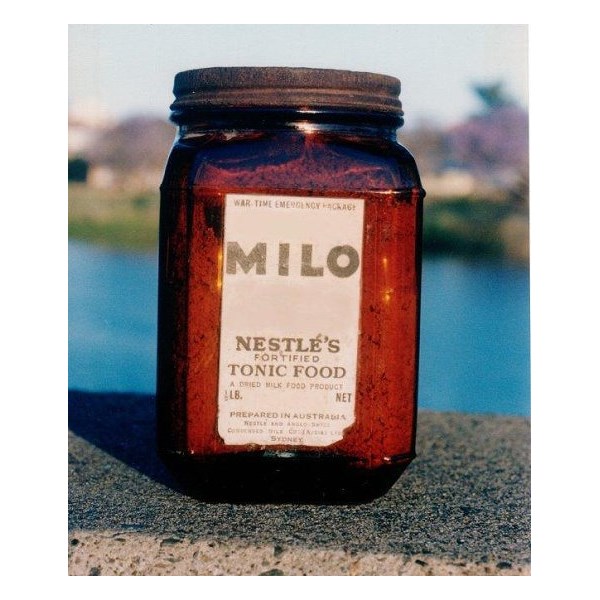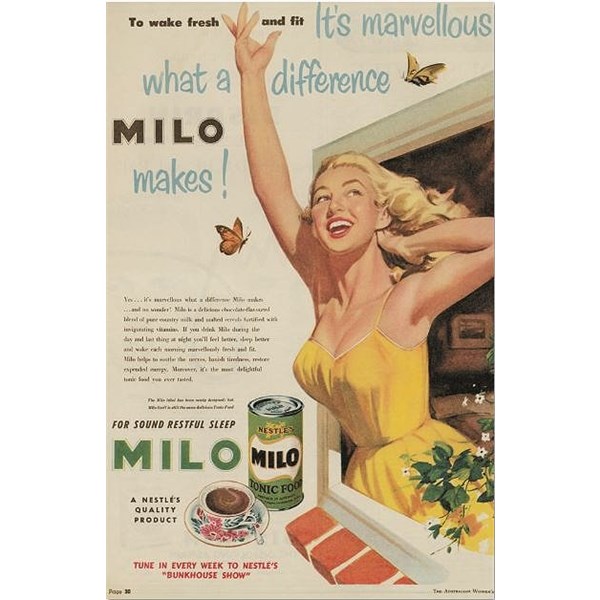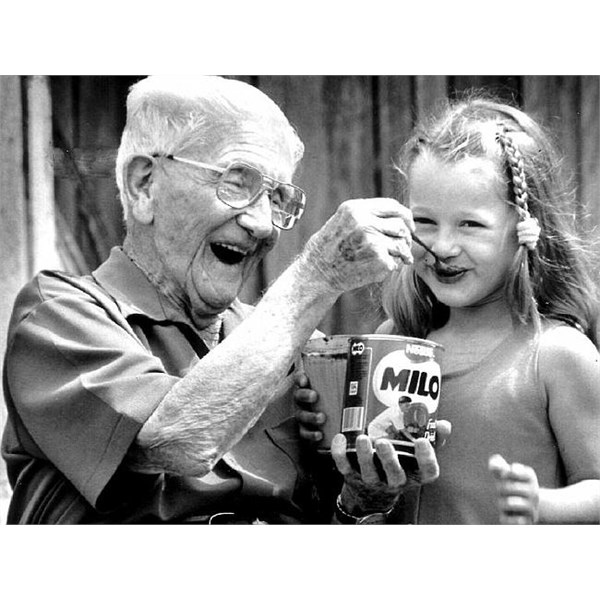Did you know that
MILO comes from humble Aussie roots?
MILO was developed in the 1930s during the depression as a direct response to the fact that children were not receiving enough nutrients from their daily diet.
Thomas Mayne, a Nestlé Engineer, created the nutritious and delicious beverage using local milk knowledge and Swiss cocoa expertise. He named the drink
MILO after the Greek mythical character
Milo, who was known for his strength.
MILO was launched in 1934 at the
Sydney Royal
Easter show in an area used to showcase new products to the public. This coincided with the opening of a local production plant for
MILO located in Smithtown, in rural NSW, where it is still produced today.

Milo over the years has stayed fairly close to its original branding
Most commonly sold as a powder in a green tin, often depicting various sporting activities,
Milo is available as a premixed beverage in some countries, and has been subsequently developed into a snack bar and breakfast cereal. Its composition and taste differ in some countries.
Milo is manufactured by evaporating the water content from a thick syrup at reduced pressure. The thick opaque syrup is obtained from malted wheat or barley. The whole process takes around an hour but operates in a continuous mode. At the bottom of the box the varying sized chunks of soft solid, from fist size to fine powder, fall from the last
conveyor into an airlock where they are brought back to atmospheric pressure. The solid is introduced into a hammer mill where it is broken up into the final granular form. The rather hygroscopic granular powder is promptly packaged into cans by filling them from the "bottom", because the "top" end has been previously fabricated with an aluminium foil seal beneath the lid. The cans then have the tinplate bottoms affixed by a roll seam and the paper label is applied to complete the product. The prompt packaging ensures the product remains fresh and dry. Some other chocolate drink bases, such as Ovaltine, are made by a similar series of processes.
Milo contains some theobromine, a xanthine alkaloid similar to caffeine which is present in the cocoa used in the product; thus, like chocolate, it can become mildly addictive if consumed in quantities of more than 15 heaped teaspoons per day.

Milo Jar, Wartime Emergency package

Wartime era tin of Milo
In Australia and most other countries, the packaging is green and depicts people playing various sports on the tin. A higher malt content form also exists in Australia and is marketed in a burgundy coloured tin which is usually only available in the 375g size. An organisation called "
Milo Cricket", which operates in most areas by volunteers, gives participating children small packets of
Milo to eat or drink. The commercials and taglines are "Go and go and go with Milo". A recent Australian commercial incorporating this slogan depicts four generations of women on a skipping rope singing "and my mum gave me
Milo to go and go and go." The tag "I need my
Milo Today" is also used. The packaging of tins of
Milo in Malaysia and Singapore are also green and also have people playing sports on the tins. In Colombia,
Milo is closely tied to football (soccer), and the slogan several generations have sung is
Milo te da energía, la meta la pones tú ("
Milo gives you the energy, you set the goal").
Milo is very popular in Malaysia and Singapore, where the brand name is synonymous with chocolate flavoured drinks:
Milo has a 90% market share in Malaysia (not the often quoted 90% worldwide share of
Milo consumption), and Malaysians were said to be the world's largest consumers of
Milo. This is because
Milo was once used as a nutrient supplement when it was first introduced in the country, and has thus gained a reputation as a 'must have' drink for the old and the younger generations.
Milo manufactured in Malaysia is made to dissolve
well in hot water to produce a smooth hot chocolate drink, or with ice added for a cold drink. "
Milo Vans" were often associated with sports days in these two countries, during which primary school pupils would queue up to collect their cups of
Milo drinks using coupons.

A MILO Advertisement in 1958
In Peru, during the 1970s military dictatorship,
Milo labels displayed Peruvian motifs, such as photos and pictures of Peruvian towns, history, crops, fruits, animals, plants, as an educational aid. After 1980, when the military left power, sports predominated on the labels.
The Indian version is no longer in production because of intense competition from other beverages.
Nestlé has now introduced a Canadian version of
Milo. It is made in Canada. It dissolves rapidly like Nesquik, probably due to market expectations, but still retains the malt flavour. It is also sweeter than other varieties. This
Milo as the brand has been in Eastern Canada since the late 1970s with the influx of people from previous British colonial territories such as the Caribbean and Hong Kong, and India. It was available in mostly small ethnic grocery stores, especially Caribbean food stores. It has recently been selling at larger chains to beef up their share in the ethnic market in Canada, and is now available in
places like Superstore, Extra Foods and London Drugs. Some East Asian supermarkets (such as T&T Supermarket in Edmonton, Vancouver, Toronto and Calgary) will carry the version imported from China or Hong Kong.
Aside from the International section of specific grocery stores and certain oriental grocery stores, Nestlé does not market
Milo in the
United States.
It can also be found in the UK in some Sainsbury's and Tesco supermarkets, which import it from Kenya. Oriental food specialists, such as Mini
Siam Oriental Foods and Hoo Hing also stock it. A similar product called Ovaltine is most popular with UK consumers.
In Ireland,
Milo can be found in many Asian or African stores. Typically they will stock Kenyan or Filipino
Milo.
In China
Milo is commonly sold in western supermarkets, but also smaller convenience stores. Usually packaged in a 240gram flexible foil pouch, single drink packets can also be purchased. The
Milo itself contains more milk solids than the Australian
Milo, and so it is not necessary to add milk before consumption.
Milo has been available for many years in a malted flavour, marketed in a burgundy can alongside the traditional green tin.

Former chief industrial chemist for Nestle Tom Mayne in 1991 with Lauren Mareschi, 5
In Australia, a new version of
Milo called
Milo B-Smart was released in 2008 (the original and malt
Milo varieties remain); which is of a finer texture and has added B vitamins and iodine. It has a different taste from the original
Milo formula and is marketed as a health food for children.
MILO who just so happen to be celebrating the 80th Anniversary this year.
.